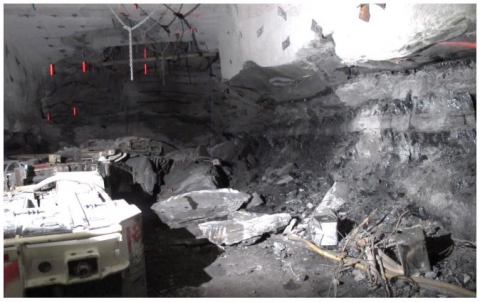Accident Report: Fatality Reference
PDF Version
COAL MINE FATALITY --On Friday, March 25, 2016, a 48-year-old continuous mining machine operator, with 30 years of mining experience, was fatally injured when an overhanging section of a rock rib fell and pinned him against the haulage equipment. The fallen rib was approximately 44 feet long, 4 feet wide, and 2 feet thick. The victim was remotely operating a continuous mining machine that was being used to excavate material during the construction of a coal transfer shaft. The area where the accident occurred had a depth of cover of approximately 1,950 feet and a height of approximately 17 feet.

Best Practices
- Be aware of potential hazards at all times when working or traveling near mine ribs, especially when conditions exist that could cause roof or rib disturbance. Take additional safety precautions in these conditions and when mining heights increase.
- Do not stand between ribs and remotely controlled face equipment.
- Know and follow all provisions of the approved roof control plan. Recognize that this plan has minimum requirements and additional measures must be taken as mining conditions warrant.
- Train all miners to conduct thorough examinations of the roof, face, and ribs where miners will be working or traveling. Correct all hazardous conditions before allowing miners in such areas. Continuously watch for changing conditions and conduct more frequent examinations when abnormal conditions are present.
- Pay particular attention to deteriorating roof and rib conditions when working in, or traveling through, older areas of the mine. Provide additional training for specialized work, such as outby construction, emphasizing best practices for each specific task.
- Perform a site-specific risk assessment for underground construction projects since unusual hazards may be encountered. Identify and correct hazardous conditions related to falls of the roof, face, and ribs.
- Install rib bolts on cycle and in a consistent pattern for the best protection against rib falls.
- Provide additional support when fractures or other abnormalities are detected and use appropriate standing support beneath overhanging brows if they cannot be taken down or adequately bolted.
- Adequately scale any loose rib material from a safe location with a bar of suitable length.
- Historically, rib related accidents occur in areas where the mining height exceeds 7 feet and the cover is more than 700 feet. In such areas, make frequent examinations and take proactive measures to assure adequate, effective rib support is installed and maintained.
Additional Information
This is the fourth fatality reported in calendar year 2016 in the coal mining industry and the second fatality classified as Fall of Rib. As of this date in 2015, there were five fatalities in the coal mining industry, including two fatalities in this classification.
